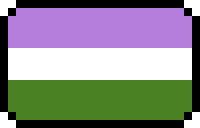
Genderqueer

Table of Contents

Introduction
Genderqueer visibility day is observed annually on April 25th. International genderqueer pride day is the 14 of July.

General Information
Genderqueer can be used as either an umbrella term for anyone with a non-normative relationship with gender, or as a gender identity on its own. Many people use the term "nonbinary" interchangably with the term "genderqueer" though not everyone who identifies as one identifies as both, and there is debate over the distinctions between the two terms. Some (but not all) genderqueer people identify as transgender. Some people may identify as genderqueer for political reasons, deliberately playing with gender in a provocative way. The term may also be used by those who do not wish to disclose the specifics of their gender identity.
Someone who identifies as genderqueer may use other labels, or simply identify as genderqueer. Someone who identifies as genderqueer may describe their identity as any of the following; having an overlap or blurred lines between gender identity, being a male woman, having a gender identity that is neither male nor female, a combination of two binary genders, on a continuum between those two genders, identifying as many genders, being a female man, not placing a name on their gender, preferring to dress androgynously or as the opposite gender, or being neither woman nor man.
While the presentation of genderqueer individuals can vary, most genderqueer people present in ways that contradict what is traditionally expected of transgender people. The pronouns used by those who identify as genderqueer varies from person to person.

History
The history of the word "genderqueer" is a tricky one. Some articles regarding the term genderqueer credit the term as originating in obscure zines from the 1970s, however the issue with things originating from obscure zines is that they are therefore difficult to find and share. An associate of mine, however, was able to find an old pin with the word "genderqueer" featured on it. The speculated date for this pin is anywhere from between 1977 to 2010. It is entirely possible that the button is from the 70s, but cannot be confirmed.
The earliest confirmed written usage of gender queer (as two separate words) can be found on page 120 of the second edition of "The Welcoming Congregation" written by Scott W. Alexander and Keith Kron in 1990. This book defines gender queer as "A person whose understanding of her/hir/his gender identification transcends society's polarized gender system."
The earliest known written usage of genderqueer being written as a single word can be found in the spring 1995 issue of the newsletter known as "In Your Face: Political Activism Against Gender Oppression" which was written by Riki Anne Wilchins. The term picked up steam throughout the 90s, and is still used by various people today (including the creator of The Transgender Dictionary).

Genderqueer Flag
The most widely used genderqueer flag was designed by Marilyn Roxie in June of 2012. This is the color corrected version of the one that she originally designed in 2011.

The top lavender stripe in the genderqueer flag represents androgynes & androgyny. The mixture of pink and blue (colors found on the transgender flag) also represents a combination of both masculine and feminine characteristics. The lavender also represents the "queer" in "genderqueer" as lavender has historically been a color used to represent being queer.
The center white stripe in the genderqueer flag represents being agender, genderless, having no gender, or having a neutral gender. The stripe also reflects the center white stripe of the transgender flag.
The bottom dark chartreuse green stripe is the inverse of lavender. Symbolizing growth and renewal, the green stripe in the genderqueer flag represents those who identify as nonbinary or outside the gender binary.

External Links

Flag Resources
- Good Good Good: Kamrin Baker: 01/04/2024: What Is the Genderqueer Pride Flag & What Does It Mean? (https://www.goodgoodgood.co/articles/genderqueer-pride-flag) - article about the genderqueer flag
- Heckin Unicorn: 09/16/2021: What is the Genderqueer pride flag and what does it mean? (https://heckinunicorn.com/blogs/heckin-unicorn-blog/what-is-the-genderqueer-pride-flag-and-what-does-it-mean) - short blog post about the meaning of the genderqueer flag
- Marilyn Roxie - Genderqueer Flag (https://marilynroxie.com/GENDERQUEER-FLAG) - creator of original flag with original meanings provided
- Queer in the World: Cecilia Miller: 10/14/2023: What Exactly Is The Genderqueer Pride Flag, And What Does It Mean? (https://queerintheworld.com/genderqueer-pride-flag/) - article regarding genderqueer pride flag meaning
- Sexual Diversity: 11/08/2022: Genderqueer Pride Flag - blurb regarding genderqueer pride flag meaning and history
- USA Today: Clare Mulroy: 06/05/2024: Pride flag colors: What genderqueer, gender-fluid and nonbinary flags represent - short article regarding the colors and meanings of these three flags
- Wayback Machine: Genderqueer and Nonbinary Identities: 01/06/2019: The Genderqueer Flag in 2019 (https://web.archive.org/web/20240918170406/https://genderqueerid.com/) - article regarding history, usage, and meaning of the genderqueer pride flag

History Resources
- Digital Transgender Archive: 1977: Button Collection - old button that reads "transsexual transgender transgressive, genderqueer, two-spirited"
- Digital Transgender Archive: 199X: Riki Anne Wilchins' Flyers: The Transexual Menace: Get Your Diagnoses Off Our Bodies and Off Our Kids! Flyer (https://www.digitaltransgenderarchive.net/files/1r66j116v) - Institute for the Psychoanalytic Abuse of Gender-Variant Children: The Search for Why Psychiatrists Want to Enforce Gender Norms Flyer by the Transexual Menace
- Digital Transgender Archive: 1994: Riki Anne Wilchins' Flyers: The Transexual Menace: HRCF: GenderQueers Deserve Rights, Too! Flyer (https://www.digitaltransgenderarchive.net/files/0p096692m) - flywer with early mention of genderqueer term
- Digital Transgender Archive: Spring 1995: Riki Anne Wilchins: Transexual Menace, In Your Face: Political Activism Against Gender Oppression (about) (https://www.digitaltransgenderarchive.net/files/1831ck00f) - about the newsletter which contains what is most commonly credited as the earliest mention of the term genderqueer
- Digital Transgender Archive: Spring 1995: Riki Anne Wilchins: Transexual Menace, In Your Face: Political Activism Against Gender Oppression (pdf) (https://www.digitaltransgenderarchive.net/downloads/1831ck00f) - read the first known usage of the word "genderqueer" found in this old newsletter
- Digital Transgender Archive: 1996: Riki Anne Wilchins' Flyers: The Transexual Menace: Support Our GenderQueer Youth! Flyer (https://www.digitaltransgenderarchive.net/files/wm117p00q) - Tell the School System and the Country: Burlington Has No Room for Intolerance or Bigotry. Flyer by the Transexual Menace
- Open Library: 1990: The Welcoming Congregation: Second Edition: Scott W. Alexander & Keith Kron (https://openlibrary.org/books/OL1618429M/The_Welcoming_congregation) - page 120 has the eariest known usage of the two word term gender queer
- Them: 12/07/2018: Jacob Tobia: InQueery: The History of the Word "Genderqueer" As We Know It - Watch nonbinary author Jacob Tobia explain the history and popular usage of the term in this episode of InQueery. (contains video)
- Freaks on the Edges: Transness Through Decades of Queercore Zines Ashton Thorne, Department of Women’s and Gender Studies (https://our.unc.edu/wp-content/uploads/sites/1148/2023/04/THORNE-poster-2023.pdf)
- Archive 09/2022: Transness in Queercore Zines by Ashton Thorne (https://archive.org/details/queercorezinetransness/page/n7/mode/2up)
- Wayback Machine: Genderqueer and Nonbinary Identities: 12/04/2011: Genderqueer History (https://web.archive.org/web/20241125182948/http://genderqueerid.com/gqhistory) - article regarding history of the genderqueer community

Wiki Resources
- Britannica: Genny Beemyn: 04/07/2025: Genderqueer (https://www.britannica.com/topic/genderqueer) - encyclopedia article regarding genderqueer
- Gender - Fandom - Gender Wiki - Genderqueer (https://gender.fandom.com/wiki/Genderqueer) - wiki regarding genderqueer meaning, usage, and alternate flags
- LGBTQIA - Fandom - Wiki - Genderqueer (https://lgbtqia.fandom.com/wiki/Genderqueer) - wiki regarding genderqueer meaning, history, flag, and distinctions between other genders
- Nonbinary Wiki - Genderqueer (https://nonbinary.wiki/wiki/Genderqueer) - wiki regarding genderqueer meaning, usage, history, real people who are genderqueer, fictional characters who are genderqueer, and distinctions between similar terms
- Wikipedia - Gender Queer (https://en.wikipedia.org/wiki/Gender_Queer) - wikipedia article for genderqueer

Ally Resources
- Genderqueer: micah: 04/17/2013: Explaining Genderqueer To Those Who Are Not (https://genderqueer.me/2013/04/17/explaining-genderqueer-to-those-who-are-not/) - article about what genderqueer is in response to someone who does not understand
- Queer in the World: Cecilia Miller: 10/14/2023: What Does Genderqueer Mean? + Other Genderqueer Information To Help You Be A Better Ally! (https://queerintheworld.com/what-does-genderqueer-mean/) - article regarding genderqueer meaning and allyship
- Very Well Health: S. Nicole Lane & Lauren Schlanger, MD: 12/02/2024: What Is Genderqueer? - article regarding genderqueer meaning, history, allyship, and comparison to other terms
- Very Well Mind: Elizabeth Boskey, PhD & Sean Blackburn: 02/14/2023: What Does It Mean to Be Genderqueer or Nonbinary? - article regarding genderqueer meaning, similar terms, and allyship

Additional Resources
- baike baidu - genderqueer (https://baike.baidu.com/item/%E6%80%A7%E5%88%AB%E9%85%B7%E5%84%BF/55793875) - this resource is in chinese
- Genderqueer (https://genderqueer.me/) - blog with queer articles and such
- Healthline: KC Clements: 02/01/2024: What Does It Mean to Be Genderqueer? (https://www.healthline.com/health/transgender/genderqueer) - article about genderqueer meaning, usage, distinctions
- Huff Post: Jacob Tobia: 06/10/2014: Why I'm Genderqueer, Professional and Unafraid (https://www.huffpost.com/entry/genderqueer-professional_b_5476239) - For transgender and gender non-conforming people like myself, the question of what to wear to work becomes an exhausting question of identity and of survival. For us, the question changes from "how do I present my best self at work?" to "can I present my best self at work?"
- My Husband Betty: 10/19/2003: Helen Boyd: Riki Wilchins on the TG spectrum (http://www.myhusbandbetty.com/2003/10/19/riki-wilchins-on-the-tg-spectrum/) - essay about genderqueer
- PBS: Corinne Segal: 04/30/2015: Photo essay: Exploring the genderqueer community (https://www.pbs.org/newshour/arts/photo-essay-exploring-genderqueer-community) - series of photos demonstrating the trans joy found in being genderqueer
- Psych Central: Francis Kuehnle, MSN, RN-BC & Zuri White-Gibson: 05/17/2022: What Does It Mean to Be Genderqueer? - article explaining being gender queer as well as the gender binary and how genderqueer interacts with sexuality and other terms
- Reddit - r/Genderqueer (https://www.reddit.com/r/genderqueer/) - subreddit for those who are genderqueer or questioning if they are genderqueer
- Trans Language Primer - Genderqueer - blurb regarding the meaning of the term genderqueer
- Wayback Machine: Genderqueer and Nonbinary Identities: 08/11/2011: Answering Gender Questions: Coining Genderqueer, Queer Fluidity, Gender-Normative (https://web.archive.org/web/20241208005251/https://genderqueerid.com/post/8813994851/answering-gender-questions-coining-genderqueer) - reference to earliest written usage of the term genderqueer, as well as other explanations of genderqueer

